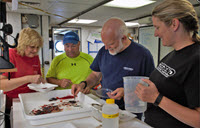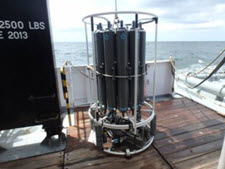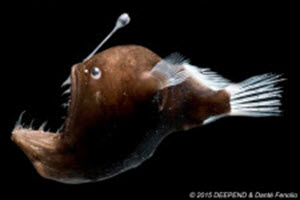Category Archives: DEEPEND
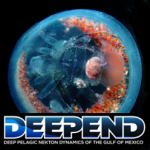
“The BP Oil Spill and Its Aftermath – Exploring Through Art” is a middle and high school level lesson plan that utilizes art to explore oil spill science. During the lesson, students will engage in discussions about the Deepwater Horizon oil spill, reflect on and create art related to the spill, and explore ongoing research Read More
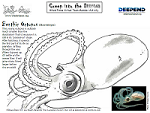
Six coloring sheets depict some of the diverse sea creatures that researchers encountered during research cruises. These coloring sheets were developed in partnership with Whale Times, Inc. for a series of summer camps based on Deep-Pelagic Nekton Dynamics (DEEPEND) consortium research called Creep into the DEEPEND. See below for free, printable PDFs! Anglerfish Coloring Sheet Read More

There are hundreds of deep-pelagic fish species in the Gulf of Mexico, and we are continuously learning about their diversity and behaviors. These short videos, hosted by kid’s science mascot Squirt the Squid, feature research into the diverse and fascinating deep-sea creatures inhabiting the Gulf of Mexico. Video 1: Cephalopods Join Squirt as he discusses Read More
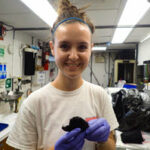
The ocean’s deep-pelagic ecosystem is the largest and least understood habitat on Earth. In the Gulf of Mexico, it was the largest ecosystem affected by the Deepwater Horizon incident. Because there was very limited pre-spill data about deep-pelagic organisms’ biodiversity, abundance, and distribution, it is difficult to determine how oiling may have affected different deep-sea Read More

The Deepwater Horizon oil spill overlapped with the spawning activities of many ecologically and economically important tuna species. However, the significant knowledge gap regarding early life stage tuna taxonomy and distribution makes it difficult to understand how the spill may have affected them. As a graduate student, Nina Pruzinsky examined the abundance, distribution, and morphological Read More
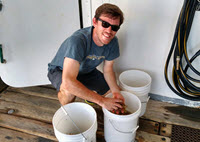
The deep-pelagic habitat (200 m depth to just above the seabed) is the largest habitat in the Gulf of Mexico, yet we know very little about it compared to coastal and shallow-water habitats. Our limited understanding of this major marine habitat makes it extremely difficult to assess the effects of disturbances such as the Deepwater Read More

Free, downloadable classroom materials covering topics ranging from bioluminescence, marine environments, hydrothermal vents, food webs and Light in the deep sea – including curricula and experiment instructions. Grades 9th – 12th Bioluminescence Candy Chemosynthesis Hydrothermal Vent Food Web Oceanographic Terms and Equipment ROV in a Bag Water-down Topographic Map Marine Environments Teaching Module Light in Read More

Free, downloadable classroom materials covering topics ranging from the BP Oil Spill and its aftermath explored through art, marine environments, hydrothermal vents, food webs and light in the deep sea – including curricula and experiment instructions! Grades 6th – 8th Hydrothermal Vent Food Web Light at the Bottom of the Deep, Dark Ocean? Marine Environments Read More
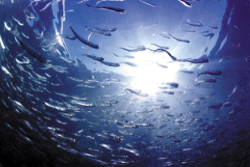
Free, downloadable classroom materials covering topics ranging from bioluminescence to hydrothermal vent food webs and include curricula, experiment instructions, and coloring sheets! Taking Science Deeper Activities Grades K – 5 Book 1: Introduction to the Deep Sea Book 2: Deep-Sea Animals Book 3: Hagfish Day! Book 4: Ocean Currents and Pollution Awareness Coloring Sheet – Read More
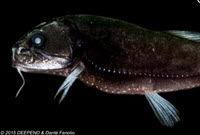
The Smithsonian’s Ocean Portal published an article about the diverse deep sea species found in the Gulf of Mexico following the Deepwater Horizon incident. The DEEPEND research consortium identified nearly 800 different species in Gulf waters, including 180 species not previously observed in the Gulf of Mexico region. Read the article The Gulf of Mexico: Read More
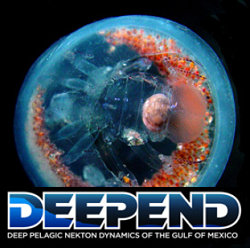
Researchers performed 99 trawl deployments (over 500 samples) during five Gulf of Mexico research cruises. The photographic timeline progresses through catches from different cruise trawls to highlight deepsea biodiversity, including some extremely rare deepsea species. Explore the timeline here!

The new module Nature of Science targets grades 6-12 and utilizes consortium research data to clearly describe the scientific method, including what is science, how is science conducted, and how is science communicated. The full 45-page module is available for download from the DEEPEND website and here on the GoMRI Education site.

The module is the fourth in a series of marine environment-focused teaching and learning modules developed by the consortium for grades 6 – 12. This module focuses on navigating marine environments, particularly historical and current human navigation and animal navigation. The module is available for download here. This module was developed by the DEEPEND (Deep-Pelagic Nekton Read More

Deep-sea investigators served as consultants for their partner Oregon Coast Aquarium’s educational infographic about diel vertical migration – the largest animal migration phenomenon on earth. The consortium has printed several copies of the poster to distribute to teachers as well as a large banner for use during outreach events. Download your own copy of the Read More

Scientists are finding fascinating discoveries in the largely unknown deep waters of the Gulf of Mexico. Some fishes, invertebrates, and bacteria have evolved a special adaptation to living in dark conditions using bioluminescence. What’s new is the discovery of specific bacteria species that live symbiotically on anglerfish and emit light. The Smithsonian recently published an Read More
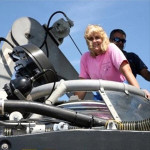
Dr. Frank works with the consortium’s crustacean team studying creatures such as crabs, lobsters, shrimp, and krill. She speaks about her research and shares why getting a job as an aspiring female scientist was very challenging.

There are hundreds of deep-pelagic fish species in the Gulf of Mexico, but we know very little about their taxonomy, diversity, and population sizes. Max Weber plans to catch fifteen individual specimens of each of the 500 known deep-sea Gulf fish species to help us better understand these organisms and how the Deepwater Horizon oil Read More

Christia Hewlett was the official Teacher-At-Sea during the consortium’s most recent research cruise. She documented the equipment, experiences, and even the researchers on board for the DEEPEND blog. You can find all of her posts about the cruise here. “I hope that I will be able to take back what I have learned and share Read More

The Deep-Pelagic Nekton Dynamics (DEEPEND) Consortium has created lesson plans for “Taking Science Deeper” Activities. Book 1: Introduction to the Deep Sea Book 2: Deep-Sea Animals Book 3: Hagfish Day! Book 4: Ocean Currents and Pollution Awareness For additional educational materials from DEEPEND, click here.
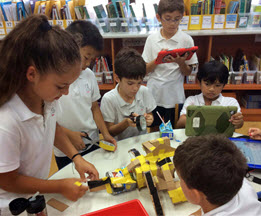
Communicating oil spill research is essential to improve society’s understanding about spills and their ability to respond to and mitigate them. The Gulf of Mexico Research Initiative (GoMRI) has been funding spill-related research since 2010. Here are ten outstanding education products and resources that GoMRI and its science community have developed to share what they Read More

Story posted by Nina Pruzinsky on DEEPEND’s BLOG On Friday, March 4, 2016, Mike Novotny and Nina Pruzinsky visited Mr. Kyle Lendick’s 6th grade Marine Science classes at New River Middle School. The three classes spent several weeks completing Deep-Pelagic Nekton Dynamics (DEEPEND)’s grade 6-8 lesson plans (found in the Education/Outreach section under Education, Resources, Read More
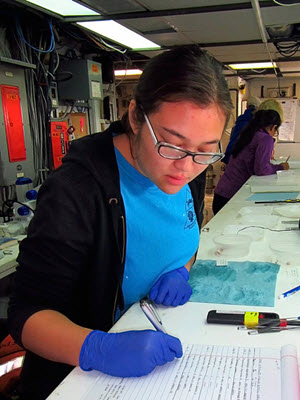
Laura Timm examines connections among shellfish ecology and evolution to help scientists understand how the Deepwater Horizon oil spill affected certain Gulf of Mexico species: “My work focuses on establishing pre-spill baselines and comparing them to samples taken 3-7 years after the oil spill, providing a timeline of crustacean recovery.” Pursuing a Ph.D. in biology Read More
The short video depicts a small crustacean called an amphipod, which uses large claws to not only eat its prey but also use their resources to build a gelatinous home around itself. You can watch the video and read a bit more about amphipods. Deep sea amphipod! Here we have a video of a deep Read More
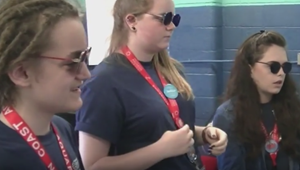
This video clip by Oceanscape Network depicts how water can affect the color of light and how deep sea animals use this for camouflage. Students created underwater creatures out of colored paper and determine which colors offer the best camouflage. Credits: DEEPEND

This kid-friendly slideshow uses photos and helpful captions to explain researchers’ routines aboard the ship and how they operate various equipment to collect and analyze samples. For more videos like DEEPEND Slideshow Depicts Life Aboard a Research Vessel, click here.


